Japanese Cooking Tips and Tricks You Should Know

Have you ever been drawn to the art of sushi or the warmth of ramen? I sure have. My first time cooking Japanese food was both exciting and a bit scary. But, I quickly fell in love with the simplicity and fun of Japanese cuisine. This guide will help you learn some key tips and tricks for Japanese cooking. It’s made for everyone, from beginners to more experienced cooks.
Japanese cooking is about more than just recipes. It’s understanding flavor balance, using fresh ingredients, and mastering certain techniques. These elements bring out the unique tastes of each dish. Are you ready to try making Japanese dishes at home? They’re sure to make your taste buds happy and impress everyone. Let’s get started and discover how to cook Japanese food with confidence and joy!
Key Takeaways
- Gain confidence with Japanese cooking for beginners.
- Learn to create authentic homemade Japanese dishes.
- Understand how to cook Japanese food with the right ingredients and techniques.
- Balance flavors to enhance the authenticity of your meals.
- Experience the joy of bringing Japanese culinary art into your kitchen.
Introduction to Japanese Cooking
Welcome to the exciting world of Japanese cooking! Ever wondered what makes it so unique and tasty? You’re in the right spot. We’ll explore Japanese cooking techniques and their traditional secrets together.
Importance of Ingredients
High-quality, seasonal ingredients are key in Japanese cooking. Japanese chefs let the natural flavors shine. This approach is tasty and healthy.
Have you ever tasted a ripe persimmon or tender sashimi? The right ingredients transform a dish from okay to amazing.
Understanding Japanese Cuisine
Let’s dive into the cultural background of Japanese dishes. They mix simplicity with elegance. Meals like sushi and tempura reflect Japan’s culture and history.
When you eat ramen or tempura next, think about the traditions behind them. Knowing these traditions helps you master Japanese recipes and appreciate their cooking art.
Essential Ingredients in Japanese Cooking
Starting Japanese cooking? Learn about the key ingredients! They’re the soul of many loved dishes. Knowing them helps achieve true flavors. Let’s look at the crucial ingredients for beginning.
Rice Varieties
Rice is key in Japanese meals. It’s in sushi and daily dishes. There are many types of rice used.
Short-grain Japonica rice is sticky. It’s good for sushi or onigiri. Koshihikari rice is sweet and chewy. It’s perfect for rice bowls. Here’s a quick comparison:
| Rice Variety | Characteristics | Popular Dishes |
|---|---|---|
| Japonica | Short-grain, sticky | Sushi, Onigiri |
| Koshihikari | Sweet, chewy | Rice Bowls, Side Dishes |
| Sasanishiki | Delicate texture | Rice Porridge, Plain Rice |
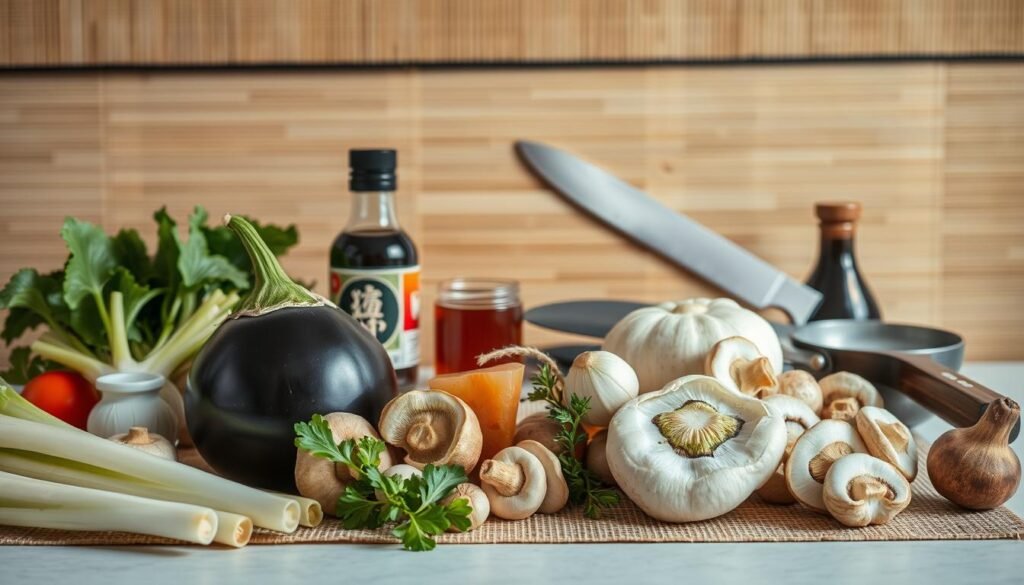
Soy Sauce and Miso
Soy sauce and miso are must-haves in Japanese kitchens. Soy sauce comes in light, dark, and tamari types. It adds a savory taste to food. Miso, a fermented soybean paste, varies in taste from sweet to rich. Together, they’re key for marinades, soups, and sauces in Japanese dishes.
Seaweed Types
Using seaweed is typical in Japanese recipes. Nori wraps sushi and is famous. But also try wakame and kombu! Wakame goes in salads and soups. Kombu makes dashi broth, a soup and stew base. These seaweeds add minerals and savory flavor to meals.
Fundamental Japanese Cooking Techniques
Learning the basics of Japanese cooking is vital for any beginner. It sets a strong foundation for making genuine and tasty dishes.
Rice Cooking Methods
Rice is a must in Japanese meals, so knowing how to prepare it is important. First, wash the rice until the water is clear to avoid stickiness. Then, let it soak for 30 minutes for even cooking. A rice cooker makes this easy and guarantees perfect rice.
Broth Preparation
Making a good broth is key in Japanese cooking, whether it’s for dashi, miso soup, or ramen. For simple dashi, use kombu and bonito flakes. Simmer kombu in water but take it out before it boils. Add bonito flakes, let them steep, then strain. This makes a tasty dashi full of umami!
Sushi Rolling Basics
Sushi rolling is easier than it looks. Start with rice mixed with vinegar on nori on a bamboo mat. Put in your chosen fillings, like fish or cucumber. Roll it tight with the mat. Wet your knife before slicing for clean cuts.
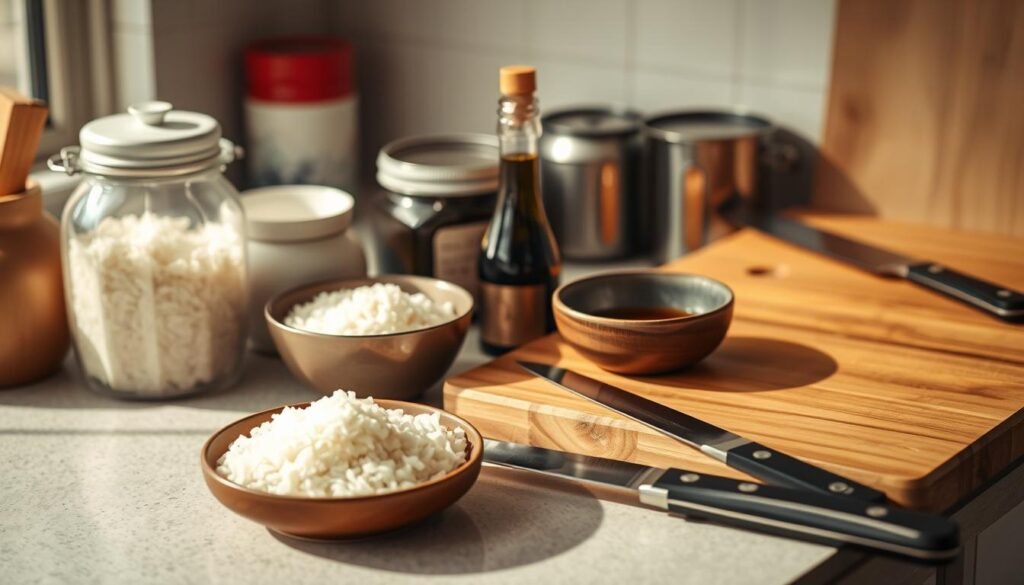
Mastering these basics—how to cook rice, make broth, and roll sushi—is important for beginners in Japanese cuisine. With these skills, you’re set to try more complex recipes and techniques!
Must-Have Kitchen Tools for Japanese Cooking
Getting the right tools can change your Japanese cooking game! These Japanese kitchen essentials make cooking fun and easy. So, what tools do you really need?

Knives and Cutting Boards
A sharp, quality knife is key. Most needed are a gyuto (chef’s knife) or a nakiri (vegetable knife). Add a solid cutting board, and cutting everything gets easier. This combo is perfect for slicing sashimi or chopping veggies neatly.
Rice Cookers
A good rice cooker is next. It’s key for perfect Japanese rice. Just add rice and water, push a button, and enjoy perfect rice every time. It’s a must-have for Japanese meals.
Bamboo Mats
Bamboo mats are a must for sushi fans. They help you roll sushi easily and get a tight roll. No matter your skill level, a bamboo mat will improve your sushi.
Exploring Japanese Sauces and Condiments
Exploring different Japanese sauces opens up a world full of tastes. These sauces and condiments make simple dishes special. Let’s dive into some to start your tasty adventure!
Teriyaki Sauce
Teriyaki sauce is key in Japanese food, offering a sweet and savory taste. It’s made from soy sauce, mirin, sake, and sugar. It makes grilled meats and veggies taste amazing. I suggest marinating chicken in Teriyaki sauce overnight for delicious flavors.
Ponzu and Vinegar
Ponzu is a citrus-based soy sauce that’s great for dressings and marinades. It adds a tangy taste and is good with seafood. Vinegars like rice vinegar are also important. They bring acidity and balance, giving dishes that perfect flavor mix.
Wasabi and Ginger
We can’t talk about Japanese sauces without mentioning wasabi and ginger. Wasabi adds a strong heat, and ginger offers a fresh zest. They’re key in the food tradition. They make sushi and sashimi taste even better, making each bite exciting.
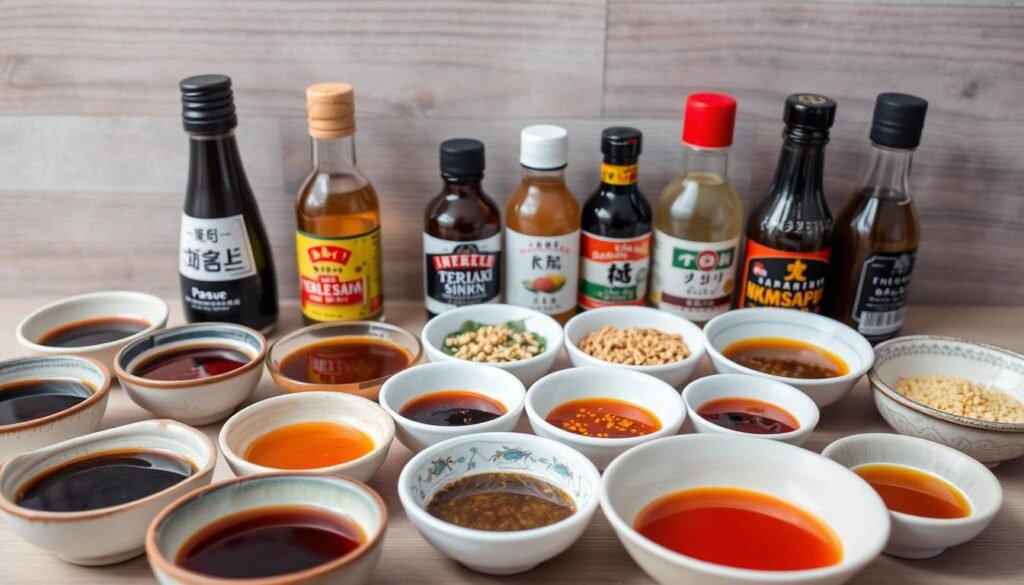
| Sauce/Condiment | Primary Ingredients | Usage |
|---|---|---|
| Teriyaki Sauce | Soy sauce, mirin, sake, sugar | Marinades, grilling, stir-fry |
| Ponzu | Soy sauce, citrus juice, vinegar | Dressings, dipping sauces |
| Rice Vinegar | Fermented rice | Pickling, sushi rice |
| Wasabi | Wasabi plant rhizome | Sushi, sashimi, flavoring |
| Ginger | Young ginger root, vinegar | Sushi accompaniment, cooking spice |
Trying these Japanese sauces will show you the rich flavors of Japanese cooking. Why not try them and bring some Japanese taste to your meals? Happy cooking!
Popular Japanese Dishes to Try at Home
Want to cook Japanese food at home? You’re in luck! I’ve spent hours making these dishes simple for you.
Ramen Techniques
Ramen is a delicious mix of flavors and textures. Whether you love tonkotsu, miso, or shoyu broth, a slow-cooked broth is key. Add toppings like soft-boiled eggs and green onions to make it better!
Tempura Basics
Making tempura at home is simple. The secret is a batter of cold water and flour, plus a bit of soda water. Then, dip your veggies or seafood in, and fry them until golden. You’ll impress everyone with this dish!
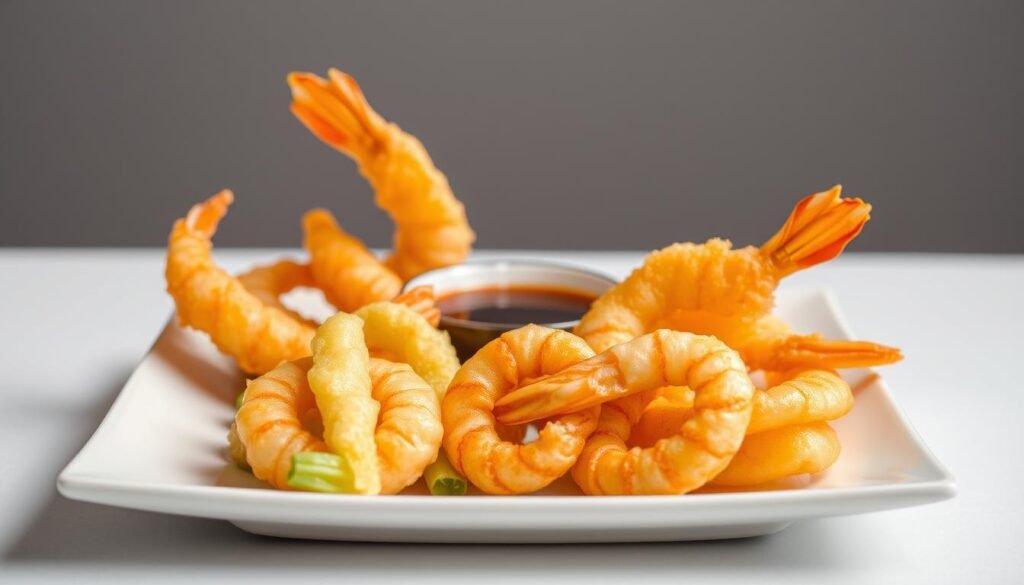
| Tempura Ingredients | Key Technique |
|---|---|
| Vegetables (carrots, sweet potatoes, eggplant) | Thinly slice for even frying |
| Shrimp | Make small cuts to prevent curling |
| Batter (flour, cold water, soda water) | Keep batter cold for crispiness |
Sushi Making at Home
Having fun making sushi at home is rewarding. Master the vinegared rice first. Use a bamboo mat for tight rolls, and get fresh fish. Try making nigiri, maki, or sashimi for tasty results!
Now, get your ingredients ready and start! Creating these dishes at home brings joy. Happy cooking!
The Art of Sushi Making
Starting your Japanese sushi making at home journey is exciting! There’s a special joy in making sushi yourself. This includes picking the best fish and learning how to roll. Now, let’s get into the art of sushi making. We’ll look at types of sushi and how to improve our skills.
Types of Sushi
Did you know sushi is a traditional dish from Japan? It has vinegared rice and different toppings like seafood or veggies. Sometimes, even tropical fruits are used. Each sushi type is unique. They mix vinegared rice with fresh toppings well. The main types of sushi are below.
| Type | Description |
|---|---|
| Nigiri | An oblong mound of sushi rice topped with a slice of raw or cooked fish, often accompanied by a dab of wasabi. |
| Maki | Sushi rolls consisting of rice and fillings such as seafood or vegetables, wrapped in a sheet of nori (seaweed). |
| Sashimi | Thin slices of raw fish or seafood served without rice, highlighting the purity of the fish’s flavor. |
*Variations of Maki include: Futomaki (big rolls with many fillings), Hosomaki (small rolls with one filling), and Uramaki (inside-out rolls with rice outside).*

Rolling Techniques
To make different sushi rolls, you need several techniques. Here’s a guide on how to make sushi with various methods:
- Futomaki (Thick Rolls): Use a full nori sheet, spread rice, add fillings, and roll tightly with a bamboo mat.
- Hosomaki (Thin Rolls): Use half a nori sheet, spread rice thinly, add a filling, and roll tight.
- Uramaki (Inside-Out Rolls): Put rice on the mat, flip the nori so rice is outside, add fillings, and roll tightly.
Practice is key to make even rolls. Don’t be upset if your first tries aren’t perfect. Enjoy the Japanese sushi making at home process!
Sourcing Fresh Fish
For great sushi, you need the freshest fish. Here’s what to look for:
- Freshness Indicators: Look for a fresh seawater smell, firm texture, and a slight sweetness.
- Popular Nigiri Fish: Salmon, Yellowtail, and Tuna are favorites, each with its own taste and texture.
- Storage and Handling: Fresh fish should be eaten soon. Keep it at 4°C for 3-5 days or freeze at -20°C for up to 14 days.
Make sure your fish is “sushi-grade” for safety and taste. Paying attention to these details will make your sushi better!
Regional Variations in Japanese Cuisine
Exploring regional Japanese cooking is an exciting food journey! Each part of Japan has its own special tastes and traditions. Let’s explore the exciting Osaka street food, the refined Kyoto cuisine, and Hokkaido’s rich seafood.
Osaka Street Food
Osaka is known as the “Kitchen of Japan,” for good reason. Its busy streets have food stalls with yummy snacks like takoyaki (octopus balls) and okonomiyaki (savory pancakes). Osaka’s vibrant street food, with its creative dishes, is a must-try for food lovers.
Kyoto Cuisine
Kyoto offers a different taste experience. It’s famous for beautiful kaiseki meals, focusing on what’s in season, light tastes, and pretty plating. Enjoy the simple yudofu (tofu hot pot) or beautifully made sweets. Kyoto cuisine shows the city’s calm beauty and sense of art in every dish.

Hokkaido Seafood
Hokkaido is best known for its fresh seafood. It’s famous for delicious uni (sea urchin), tasty crab, and fresh sashimi. Hokkaido’s clear waters and cool climate make its seafood top-notch. Try the kaisen don (seafood rice bowl) for a taste of Hokkaido’s ocean gifts.
| Region | Specialty | Description |
|---|---|---|
| Osaka | Takoyaki | Grilled octopus balls |
| Kyoto | Kaiseki | Traditional multi-course meal |
| Hokkaido | Kaisen Don | Seafood rice bowl |
Incorporating Japanese Cooking into Your Diet
Have you thought about adding healthy Japanese foods to your diet? It’s not hard at all! Japanese food gives you lots of tasty and healthy options. You can eat things like seaweed and tofu, which are good for you.
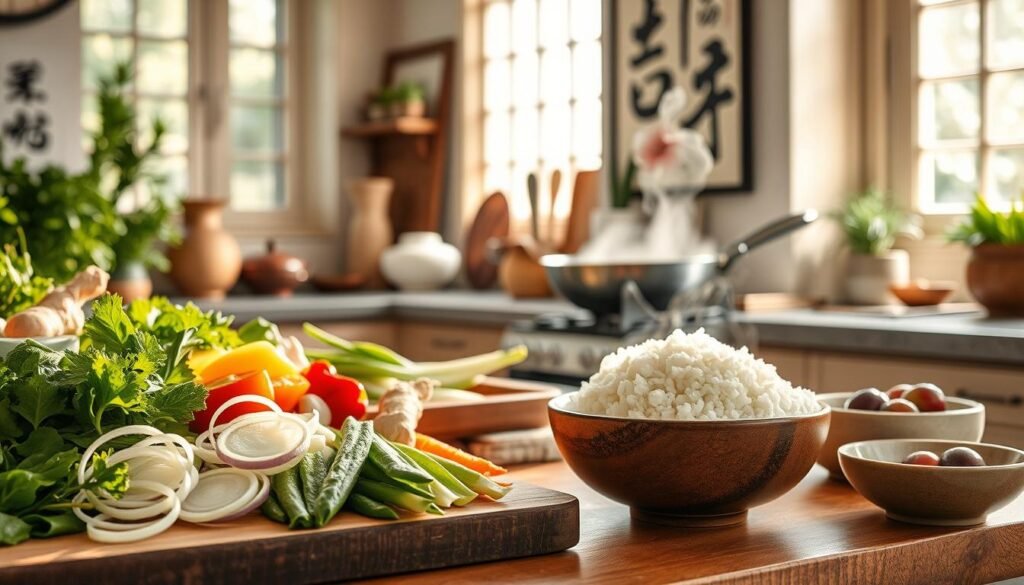
Healthy Japanese Meal Ideas
Healthy Japanese cooking is quick and simple. For a fast breakfast, have miso soup with tofu and veggies. It’s fulfilling and takes no time. Perfect for when you’re in a hurry.
For lunch, how about a chirashi bowl? It has sushi rice, raw fish, and veggies. Add sesame seeds and nori for more flavor.
Combining Flavor with Nutrition
Japanese food mixes taste with health benefits well. Try soba noodles with soy sauce for something different. Soba has lots of fiber and protein. Plus, it’s tasty.
Try grilled teriyaki salmon with steamed edamame for another delicious dish. It’s healthy and full of flavor.
Japanese cooking can be a fun part of your daily routine. It helps you eat better. Start adding these simple Japanese meals to your life. You’ll eat healthier and love your meals more!
Tips for Enhancing Flavor in Japanese Dishes
I love turning simple things into tasty Japanese dishes! The secret? It’s all about boosting flavors with some tricks. Here are my top cooking tips for umami to make your food full of bold flavors.
Umami Elements
Umami is the savory taste that makes Japanese food so good! To get this flavor, use ingredients like miso, soy sauce, and mushrooms. These add depth and richness to your cooking. For example, add miso to soup or dried shiitake mushrooms to stir-fries. It’ll change your dish in an amazing way!
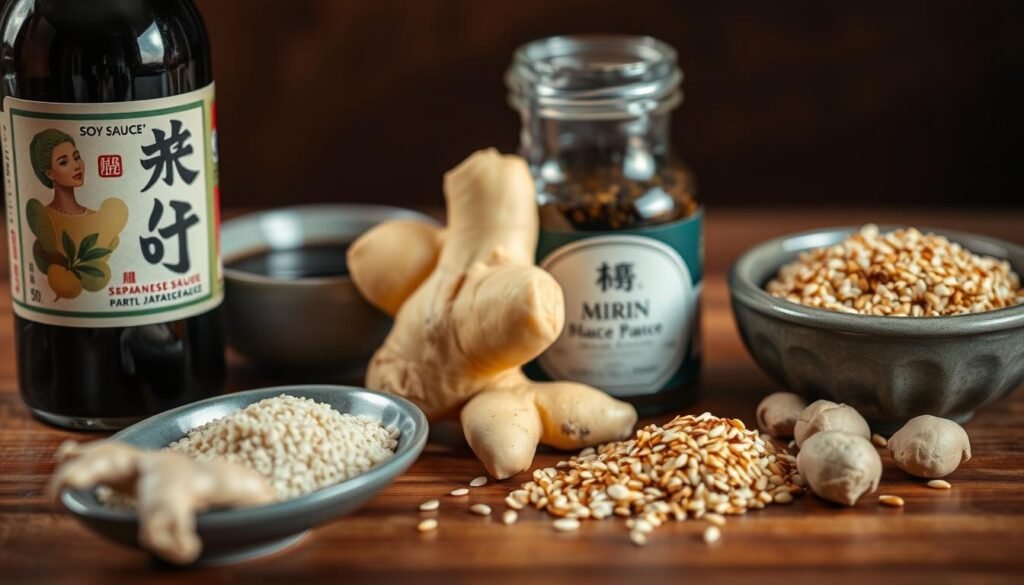
Balancing Sweet and Sour
Finding the right balance of flavors is crucial. Your taste buds love both sweet and sour. Mixing a little sugar or mirin with vinegar or citrus can create a great taste. Like in teriyaki sauce, sugar and soy sauce together taste fantastic. This balance makes your dish satisfying and full.
Garnishes and Presentation
The way you present food is important, too. Garnishes boost the taste and look of your dishes! Use fresh herbs, sesame seeds, or wasabi mayo to make your dish better in flavor and looks. A dish that looks good makes the eating experience even better.
| Element | Flavor Contribution |
|---|---|
| Miso | Savory, earthy depth |
| Soy Sauce | Salty, umami-rich |
| Mirin | Sweet, subtle tanginess |
| Fresh Herbs | Freshness, visual appeal |
Conclusion: Embracing Japanese Cooking
Learning Japanese cooking means more than new recipes. It’s diving into a culture that makes meals exciting. You’ll find many resources for all skill levels. They help you master sushi or discover miso soup’s benefits.
Resources for Further Learning
The KINSARYU Yanagihara Online Cooking School is a top pick. It includes 29 videos across 11 themes. Students learn key Japanese cooking skills like simmering and cutting raw fish. It’s ideal for those eager to cook authentic Japanese meals at home.
Just One Cookbook by Namiko Hirasawa Chen is another great resource. It has tons of recipes, clear instructions, and videos. It sorts recipes by type, making it easy for both newbies and seasoned cooks.
Joining Cooking Classes or Online Communities
Joining classes or online cooking communities is also smart. Meetup offers Japanese cooking groups globally. People share tips, inspire, and learn together. They host events and workshops, fostering a lively Japanese cooking circle.
Using these resources will improve your cooking and show you more about Japanese cuisine. It makes each meal a celebration of culture right in your kitchen!